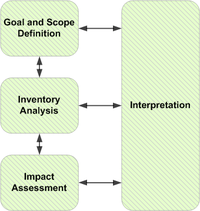
Photo from wikipedia
Objectives GI endoscopy units represent the third largest producers of medical waste. We aimed to determine endoscopic instrument composition and life cycle assessment (LCA) and to assess a sustainability proposal… Click to show full abstract
Objectives GI endoscopy units represent the third largest producers of medical waste. We aimed to determine endoscopic instrument composition and life cycle assessment (LCA) and to assess a sustainability proposal based on a mark on the instruments that identifies parts can be safely recycled or ‘green mark’. Design Material composition analysis and LCA of forceps, snares and clips from four different manufacturers (A–D) were performed with four different methods. Carbon footprint from production, transportation and end of life of these instruments was calculated. In 30 consecutive procedures, we marked the contact point with the working channel. 5 cm away from that point was considered as green mark. One-week prospective study was conducted with 184 procedures evaluating 143 instruments (75 forceps, 49 snares and 19 haemoclips) to assess the efficacy of this recyclable mark. Results Composition from different manufacturers varied widely. Most common materials were high global warming potential (GWP) waste (polyethylene, polypropylene and acrylonitrile) and low GWP waste (stainless steel). Significant differences were found for the forceps (0.31–0.47 kg of CO2 equivalent (CO2-eq)) and haemoclips (0.41–0.57 kg CO2-eq) between the manufacturers. Green mark was established 131.26 cm for gastroscope and 195.32 cm for colonoscope. One-week activity produced 67.74 kg CO2-eq. Applying our sustainability intervention, we could reduce up to 27.44% (18.26 kg CO2-eq). This allows the recycling of 61.7% of the instrument total weight (4.69 kg). Conclusion Knowledge of carbon footprint is crucial to select the most sustainable alternatives because there are large variations between brands. A mark to identify recyclable parts could reduce our environmental impact significantly.
Journal Title: Gut
Year Published: 2023
Link to full text (if available)
Share on Social Media: Sign Up to like & get
recommendations!